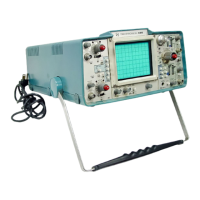Circuit Description—455/A2/B2
DETAILED CIRCUIT OPERATION
The following detailed circuit description is subdivided according to the Block Diagram in the Diagrams section. Simplified
diagrams are used where necessary for clarity. Complete schematic diagrams are located in the Diagrams section. Refer to the
Diagrams section throughout the following discussion for circuit numbers, electrical values and circuit relationships. The
waveforms and voltages shown on the diagrams are helpful for understanding circuit operation.
Diamond enclosed diagram numbers relate circuit descriptions to pull-out pages in the Diagrams section.
Digital logic devices are used to perform some of the functions in this instrument. LO and HI designations are used in this
circuit description to indicate the state of the digital circuit. HI indicates the more positive of the two levels. The specific
voltages, which constitute a LO or HI state, may vary between individual devices. Typical LO and HI logic levels are shown
on the schematic diagrams.
CALIBRATOR
The Calibrator circuit produces an accurate 300 mV square-
wave output. The circuit consists of an astable multivibrator
and an output amplifier. A 30 mA calibrator current output
is also available when a current loop1 is plugged into the
CALIBRATOR output jacks.
Multivibrator
Transistors Q376, Q382 and associated circuitry compose an
emitter-coupled astable multivibrator. The multivibrator
runs as approximately 1 kHz. The frequency is determined
by the RC time constant of C376-R377-R375. Transistors
Q376 and Q382 conduct alternately, producing a square-
wave output signal at the collector of Q382. Diodes CR372
and CR373 lim it the charge of C376 to approximately 18
volts to prevent damage to Q376 or Q382 when either is
removed or replaced while the instrument is operating.
Output Amplifier
The square-wave output signal from Q382 drives the output
amplifier Q386 from cutoff to saturation, producing an
accurate square wave at the output connector. Transistor
Q386 is cut off when the square-wave signal rises to maxi
mum and goes into saturation when the signal falls to
minimum. Amplitude adjustment R386 adjusts the current
through Q386, R387 and R388 to accurately set the cali
brator output voltage.
HORIZONTAL OUTPUT AMPLIFIER ^
The Horizontal Output Amplifier provides the final signal
amplification to drive the crt horizontal deflection plates.
The negative-going and positive-going horizontal output
signals from the Main Module drive two single-ended
feedback amplifier stages. The amplifiers have a low input
impedance and require very little voltage change at the
input to produce the desired output change.
Transistor Q234 is a constant voltage source. Transistor
Q234 and diodes CR235 — CR236 set the bases of Q232
and Q274 near the same quiescent dc level.
Transistors Q232 and Q274 are inverting amplifiers whose
collector signals drive the emitters of complementary ampli
fiers Q244 — Q246 and Q284 — Q286 respectively.
The output signal from complementary amplifier Q244 —
Q246 drives the right horizontal deflection plate. The out
put from complementary amplifier Q284 — Q286 drives the
left horizontal deflection plate.
Capacitors C236, C244 and C284 provide a signal path for
fast ac signal current from one side of the amplifier to the
other. Resistors R233 — R232 and R272 — R273 are feed
back elements in the amplifier. Capacitors C232 and C272
provide high frequency compensation.
SWEEP GATE AMPLIFIER
The Sweep Gate Amplifier amplifies the Sweep Gate Signal
(A or B selected by moving P2800) from the Horizontal
Module for output to the + GATE OUT connector at the
rear of the main module.
The Sweep Gate Amplifier consists of amplifier Q356 and
emitter follower Q358. Diode VR353 limits gate output
to +5 volts. Diode CR352 sets the quiescent output level
at about 0 volt.
To make a plug-in current loop, order Tektronix Part 012-0259-00 and modify it by replacing the 50 il resistor (inside) with a bare wire. A
current loop also can be made from 5 turns of insulated wire.
REV. A, OCT 1975
4-3

